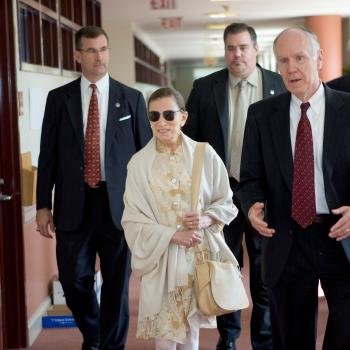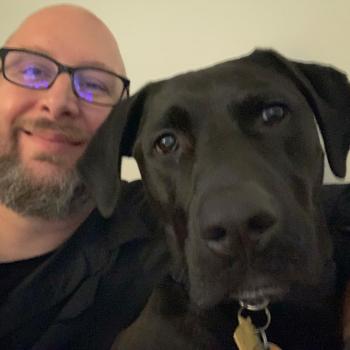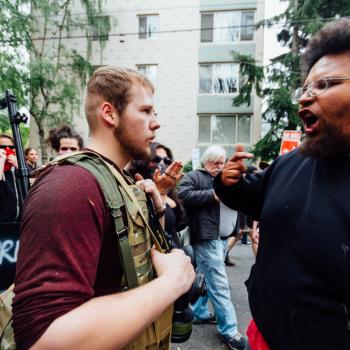It’s not news that the Evangelical church and America’s political right wing were wed long ago. It’s not news that both gather followers through virulent attacks on “the government,” or “the system,” or “fake news media.” It’s not news that—from climate change to contagion vectors to carbon dating the Earth—they are both rabidly anti-science.
I doubt anyone was truly surprised, then, when right wing pastors across the country continued holding services, even in the middle of a global pandemic spread by personal contact. Some of those pastors have now died. Many of their congregants have died. Doubtless, many more will die from first- and second-hand exposure in the weeks to come.
What does seem to be a surprise, at least for those not familiar with effective political demonstration, is just how easily one defiant pastor was shut down by a single protester.
. . .
Pastor Tony Spell of Life Tabernacle Church in Baton Rouge, Louisiana has been among the most egregious of the quarantine-breaking right wing. He believes any parishioner willing to risk their life, break the law and show up to one of his services is a “revolutionary,” a “zealot,” and a “true Christian.” He believes they “do not mind dying” in service to his church. He also—not so coincidentally—uses this revolution of his to beg for every penny of his supporters’ economic stimulus checks for the church.
Among the parishioners Spell claims do not mind dying are Harold Orillion, a 78-year-old member of Spell’s church who did die on April 15 of COVID complications. Pastor Spell claimed Orillion as one of his “right hand men,” and told reporters the coroner’s conclusions were “a lie.” Another person connected to Spell—a lawyer who broke the law to attend Spell’s church at least twice—is now hospitalized with COVID-19, but states he has “no idea” how he got infected.
. . .
Enter Trey Bennett, a 39-year-old resident of the same town as Spell’s church, a concerned member of the community that would be affected by Spell’s actions.
For about three weeks leading up to April 19, Bennett protested in front of the church. Accounts vary, but everyone agrees he was a) disruptive, b) nonviolent, and c) very clear in his message that the church should stop holding large services. Spell became increasingly annoyed with Bennett, and violently aggressive. Among other things, Spell told a local newspaper:
What would you do? You’d take your foot and stick his face in. You can quote me on that.
Still, Bennett held his ground, continuing to protest, continuing to disrupt the flow of traffic into and out of Spell’s parking lot. Eventually Spell reached his boiling point, and backed a school bus to within a few feet of where Bennett was standing. Spell said he was just picking up “black children who haven’t eaten,” (thereby also exposing one of the most disproportionately harmed communities) and was approaching Bennett to ask him to leave. Local police who reviewed the video thought differently, and arrested Spell for aggravated assault. Separately, one of Spell’s “revolutionary” parishioners, Nathan Thomas, tried to swerve into Bennett several hours later with his own vehicle, and was also arrested.
. . .
This story isn’t over. Spell is now out on bond, has hired disgraced Republican politician, judge and pedophile Roy Moore to represent him, and will fight the charges. But even at this unresolved point, there are lessons that can be learned.
Just one day before the alleged assault, I posted a column that was essentially a primer on Christian protest. In the last week of his life, Jesus Christ used many of the same strategies as Bennett to provoke the local religious authorities to violence, which led to Jesus’ eventual arrest, execution, and fulfillment of Hebrew prophecy. These are the three factors Jesus’ and Bennett’s protests share:
1) They were disruptive
Jesus chose Passover for a reason. He chose to drive livestock out of the temple and disrupt the business of merchants and moneychangers for a reason. If a protest is not disruptive, it can be easily ridiculed or ignored. Bennett stopped traffic. He upset parishioners. He made himself enough of a thorn in Tony Spell’s side that eventually Spell, predictably, was provoked to violence.
And that’s the thing about ego-driven religious authoritarians. They are predictable. They can’t stand any disruption to the flow of money or power.
2) They were nonviolent
Although Jesus did bring swords into Jerusalem for the explicit purpose of provoking the authorities, he forbade his followers from using them. The closest he came to violence was overturning a couple tables and freeing some livestock. Bennett too, was aggressive, and represented a real threat to Spell’s power, but he did not raise a hand against Spell or his parishioners. Now Spell faces assault charges, and Bennett is hopefully on his way to becoming a folk hero. The outcome could not have been more clearly in Bennett’s favor.
3) They were on message
Jesus came to fulfill Hebrew prophecy. He carefully examined and planned every step, and was explicit about his purpose. This is how he went from one of many local messianic figures of his day to global recognition as the Christ. Bennett wanted the church to behave reasonably in a time of pandemic. He identified that the church was breaking the law, was risking lives and was behaving in a very un-Christian way, and he stuck to that message. If he’d have veered off into the many disparate messages traditionally seen at anti-evangelical protests, he would have been dismissed as a kook, and eventually just ignored.
. . .
As before, I’m not suggesting anyone go out and take on a violent, right-wing, extremist Evangelical pastor like Spell. That is dangerous, and not the point of this column. What I am suggesting is that, when the time comes in your life that you feel ready to protest, if you want to make it effective, you have to make it disruptive, nonviolent, and rigidly on-message. Christ didn’t come only to show us how to behave toward the “least of these.” He also came to show us how to behave toward the oppressor. When Jesus stepped up and protested against his own religious leaders in that final week that began Easter, he did so knowing that his example would be ours to follow in all the years to come.













